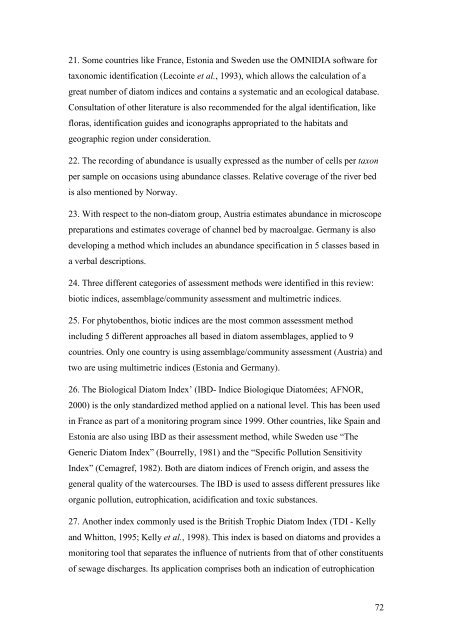Report on Harmonisation of freshwater biological methods
Report on Harmonisation of freshwater biological methods
Report on Harmonisation of freshwater biological methods
Create successful ePaper yourself
Turn your PDF publications into a flip-book with our unique Google optimized e-Paper software.
21. Some countries like France, Est<strong>on</strong>ia and Sweden use the OMNIDIA s<strong>of</strong>tware fortax<strong>on</strong>omic identificati<strong>on</strong> (Lecointe et al., 1993), which allows the calculati<strong>on</strong> <strong>of</strong> agreat number <strong>of</strong> diatom indices and c<strong>on</strong>tains a systematic and an ecological database.C<strong>on</strong>sultati<strong>on</strong> <strong>of</strong> other literature is also recommended for the algal identificati<strong>on</strong>, likefloras, identificati<strong>on</strong> guides and ic<strong>on</strong>ographs appropriated to the habitats andgeographic regi<strong>on</strong> under c<strong>on</strong>siderati<strong>on</strong>.22. The recording <strong>of</strong> abundance is usually expressed as the number <strong>of</strong> cells per tax<strong>on</strong>per sample <strong>on</strong> occasi<strong>on</strong>s using abundance classes. Relative coverage <strong>of</strong> the river bedis also menti<strong>on</strong>ed by Norway.23. With respect to the n<strong>on</strong>-diatom group, Austria estimates abundance in microscopepreparati<strong>on</strong>s and estimates coverage <strong>of</strong> channel bed by macroalgae. Germany is alsodeveloping a method which includes an abundance specificati<strong>on</strong> in 5 classes based ina verbal descripti<strong>on</strong>s.24. Three different categories <strong>of</strong> assessment <strong>methods</strong> were identified in this review:biotic indices, assemblage/community assessment and multimetric indices.25. For phytobenthos, biotic indices are the most comm<strong>on</strong> assessment methodincluding 5 different approaches all based in diatom assemblages, applied to 9countries. Only <strong>on</strong>e country is using assemblage/community assessment (Austria) andtwo are using multimetric indices (Est<strong>on</strong>ia and Germany).26. The Biological Diatom Index’ (IBD- Indice Biologique Diatomées; AFNOR,2000) is the <strong>on</strong>ly standardized method applied <strong>on</strong> a nati<strong>on</strong>al level. This has been usedin France as part <strong>of</strong> a m<strong>on</strong>itoring program since 1999. Other countries, like Spain andEst<strong>on</strong>ia are also using IBD as their assessment method, while Sweden use “TheGeneric Diatom Index” (Bourrelly, 1981) and the “Specific Polluti<strong>on</strong> SensitivityIndex” (Cemagref, 1982). Both are diatom indices <strong>of</strong> French origin, and assess thegeneral quality <strong>of</strong> the watercourses. The IBD is used to assess different pressures likeorganic polluti<strong>on</strong>, eutrophicati<strong>on</strong>, acidificati<strong>on</strong> and toxic substances.27. Another index comm<strong>on</strong>ly used is the British Trophic Diatom Index (TDI - Kellyand Whitt<strong>on</strong>, 1995; Kelly et al., 1998). This index is based <strong>on</strong> diatoms and provides am<strong>on</strong>itoring tool that separates the influence <strong>of</strong> nutrients from that <strong>of</strong> other c<strong>on</strong>stituents<strong>of</strong> sewage discharges. Its applicati<strong>on</strong> comprises both an indicati<strong>on</strong> <strong>of</strong> eutrophicati<strong>on</strong>72














![Accommodation booking form [PDF]](https://img.yumpu.com/39471785/1/184x260/accommodation-booking-form-pdf.jpg?quality=85)

